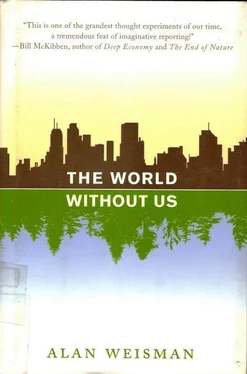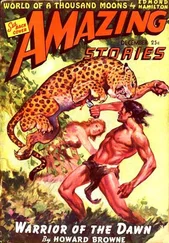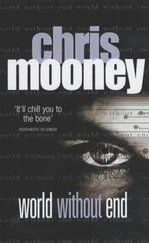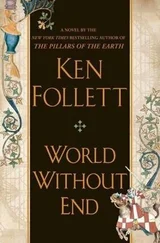“This,” Captain Moore tells his passengers, “is where all the things end up that flow down rivers to the sea.” It is the same phrase geologists have uttered to students since the beginning of science, describing the inexorable processes of erosion that reduce mountains to dissolved salts and specks small enough to wash to the ocean, where they settle into layers of the distant future’s rocks. However, what Moore refers to is a type of runoff and sedimentation that the Earth had hitherto never known in 5 billion years of geologic time—but likely will henceforth.
During his first 1,000-mile crossing of the gyre, Moore calculated half a pound for every 100 square meters of debris on the surface, and arrived at 3 million tons of plastic. His estimate, it turned out, was corroborated by U.S. Navy calculations. It was the first of many staggering figures he would encounter. And it only represented visible plastic: an indeterminate amount of larger fragments get fouled by enough algae and barnacles to sink. In 1998, Moore returned with a trawling device, such as Sir Alistair Hardy had employed to sample krill, and found, incredibly, more plastic by weight than plankton on the ocean’s surface.
In fact, it wasn’t even close: six times as much.
When he sampled near the mouths of Los Angeles creeks that emptied into the Pacific, the numbers rose by a factor of 100, and kept rising every year. By now he was comparing data with University of Plymouth marine biologist Richard Thompson. Like Thompson, what especially shocked him were plastic bags and the ubiquitous little raw plastic pellets. In India alone, 5,000 processing plants were producing plastic bags. Kenya was churning out 4,000 tons of bags a month, with no potential for recycling.
As for the little pellets known as nurdles, 5.5 quadrillion —about 250 billion pounds—were manufactured annually. Not only was Moore finding them everywhere, but he was unmistakably seeing the plastic resin bits trapped inside the transparent bodies of jellyfish and salps, the ocean’s most prolific and widely distributed filter-feeders. Like seabirds, they’d mistaken brightly colored pellets for fish eggs, and tan ones for krill. And now God-knows-how-many quadrillion little pieces more, coated in body-scrub chemicals and perfectly bite-sized for the little creatures that bigger creatures eat, were being flushed seaward.
What did this mean for the ocean, the ecosystem, the future? All this plastic had appeared in barely more than 50 years. Would its chemical constituents or additives—for instance, colorants such as metallic copper—concentrate as they ascended the food chain, and alter evolution? Would it last long enough to enter the fossil record? Would geologists millions of years hence find Barbie doll parts embedded in conglomerates formed in seabed depositions? Would they be intact enough to be pieced together like dinosaur bones? Or would they decompose first, expelling hydrocarbons that would seep out of a vast plastic Neptune’s graveyard for eons to come, leaving fossilized imprints of Barbie and Ken hardened in stone for eons beyond?
Moore and Thompson began consulting materials experts. Tokyo University geochemist Hideshige Takada, who specialized in EDCs—endocrine-disrupting chemicals, or “gender benders”—had been on a gruesome mission to personally research exactly what evils were leaching from garbage dumps all around Southeast Asia. Now he was examining plastic pulled from the Sea of Japan and Tokyo Bay. He reported that in the sea, nurdles and other plastic fragments acted both as magnets and as sponges for resilient poisons like DDT and PCBs.
The use of aggressively toxic polychlorinated biphenyls—PCBs—to make plastics more pliable had been banned since 1970; among other hazards, PCBs were known to promote hormonal havoc such as hermaphroditic fish and polar bears. Like time-release capsules, pre-1970 plastic flotsam will gradually leak PCBs into the ocean for centuries. But, as Takada also discovered, free-floating toxins from all kinds of sources—copy paper, automobile grease, coolant fluids, old fluorescent tubes, and infamous discharges by General Electric and Monsanto plants directly into streams and rivers—readily stick to the surfaces of free-floating plastic.
One study directly correlated ingested plastics with PCBs in the fat tissue of puffins. The astonishing part was the amount. Takada and his colleagues found that plastic pellets that the birds ate concentrate poisons to levels as high as 1 million times their normal occurrence in seawater.
By 2005, Moore was referring to the gyrating Pacific dump as 10 million square miles—nearly the size of Africa. It wasn’t the only one: the planet has six other major tropical oceanic gyres, all of them swirling with ugly debris. It was as if plastic exploded upon the world from a tiny seed after World War II and, like the Big Bang, was still expanding. Even if all production suddenly ceased, an astounding amount of the astoundingly durable stuff was already out there. Plastic debris, Moore believed, was now the most common surface feature of the world’s oceans. How long would it last? Were there any benign, less-immortal substitutes that civilization could convert to, lest the world be plastic-wrapped evermore?
That fall, Moore, Thompson, and Takada convened at a marine plastic summit in Los Angeles with Dr. Anthony Andrady. A senior research scientist at North Carolina’s Research Triangle, Andrady is from Sri Lanka, one of South Asia’s rubber-producing powers. While studying polymer science in graduate school, he was distracted from a career in rubber by the surging plastics industry. An 800-page tome he eventually compiled, Plastics in the Environment , won him acclaim from the industry and environmentalists alike as the oracle on its subject.
The long-term prognosis for plastic, Andrady told assembled marine scientists, is exactly that: long-term. It’s no surprise that plastics have made an enduring mess in the oceans, he explained. Their elasticity, versatility (they can either sink or float), near invisibility in water, durability, and superior strength were exactly why net and fishing line manufacturers had abandoned natural fibers for synthetics such as nylon and polyethylene. In time, the former disintegrate; the latter, even when torn and lost, continue “ghost fishing.” As a result, virtually every marine species, including whales, is in danger of being snared by great tangles of nylon loose in the oceans.
Like any hydrocarbon, Andrady said, even plastics “inevitably must biodegrade, but at such a slow rate that it is of little practical consequence. They can, however, photodegrade in a meaningful time frame.”
He explained: When hydrocarbons biodegrade, their polymer molecules are disassembled into the parts that originally combined to create them: carbon dioxide and water. When they photodegrade , ultraviolet solar radiation weakens plastic’s tensile strength by breaking its long, chain-like polymer molecules into shorter segments. Since the strength of plastics depends on the length of their intertwined polymer chains, as the UV rays snap them, the plastic starts to decompose.
Everyone has seen polyethylene and other plastics turn yellow and brittle and start to flake in sunlight. Often, plastics are treated with additives to make them more UV-resistant; other additives can make them more UV-sensitive. Using the latter for six-pack rings, Andrady suggested, might save the lives of many sea creatures.
However, there are two problems. For one, plastic takes much longer to photodegrade in water. On land, plastic left in the sun absorbs infrared heat, and is soon much hotter than the surrounding air. In the ocean, not only does it stay cooled by water, but fouling algae shield it from sunlight.
Читать дальше











